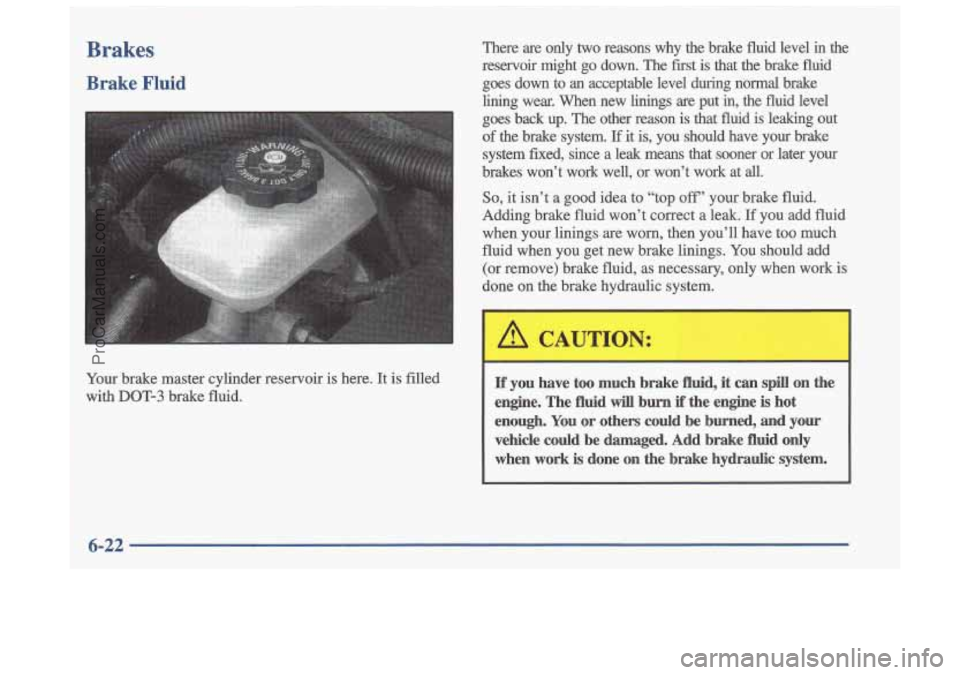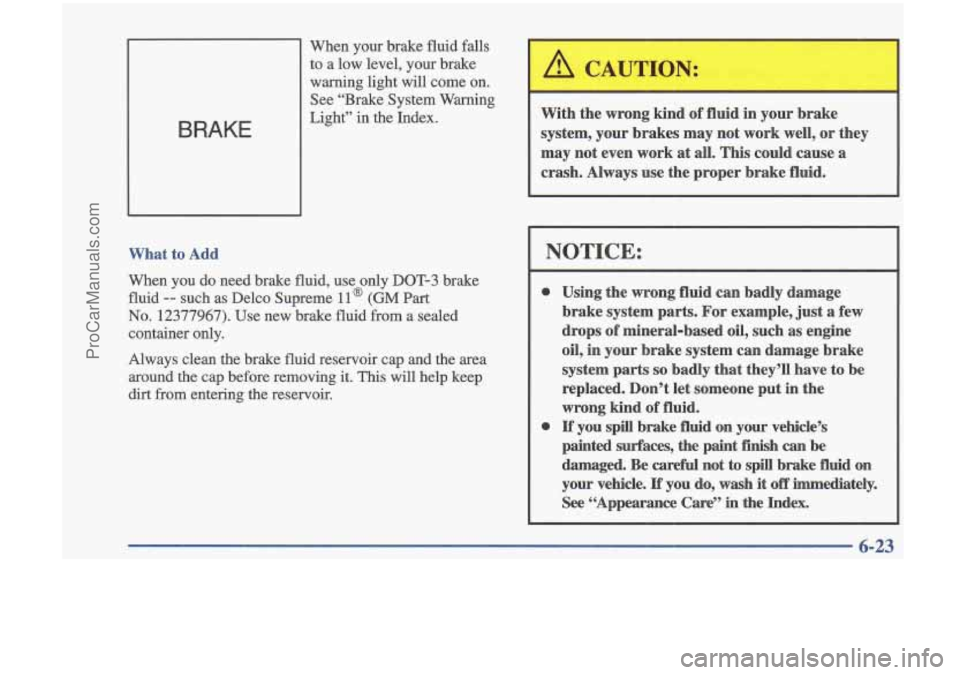Page 245 of 353

Brakes
Brake Fluid
Your brake master cylinder reservoir is here. It is filled
with
DOT-3 brake fluid. There are only
two reasons why the brake fluid level in the
reservoir might go down. The first is that the brake fluid
goes down to
an acceptable level during normal brake
lining wear. When new linings are put in, the fluid level
goes back up. The other reason
is that fluid is leaking out
of the brake system. If it is, you should have your brake
system. fixed, since a leak means that sooner or later your
brakes won’t work well, or won’t work at
all.
So, it isn’t a good idea to “top off’ your brake fluid.
Adding brake fluid won’t correct
a leak. If you add fluid
when your linings are
worn, then you’ll have too much
fluid when
you get new brake linings. You should add
(or remove) brake fluid, as necessary, only when work is
done on the brake hydraulic system.
If you have too much brake fluid, it can spill on the
engine.
The fluid will burn if the engine is hot
enough.
You or others could be burned, and your
vehicle could be damaged. Add brake fluid only when work
is done on the brake hydraulic system.
6-22
ProCarManuals.com
Page 246 of 353

1
When your brake fluid falls to a low level, your brake
warning light will come on.
See “Brake System Warning
What to Add
When you do need brake fluid, use only DOT-3 brake
fluid
-- such as Delco Supreme ll@ (GM Part
No. 12377967). Use new brake fluid from a sealed
container only.
Always clean the brake fluid reservoir cap and the area
around the cap before removing
it. This will help keep
dirt from entering the reservoir.
With the wrong kind of fluid in your brake
system, your brakes may not work
well, or they
may not even work
at all. This could cause a
crash. Always use the proper brake fluid.
NOTICE:
a
a
Using the wrong fluid can badly damage
brake system parts. For example, just a few
drops
of mineral-based oil, such as engine
oil, in your brake system can damage brake
system parts
so badly that they’ll have to be
replaced. Don’t let someone put in the
wrong kind
of fluid.
If you spill brake fluid on your vehicle’s
painted surfaces, the paint finish
can be
damaged. Be
careful not to spill brake fluid on
your vehicle.
If you do, wash it off immediately.
See “Appearance Care” in the Index.
6-23
ProCarManuals.com
Page 248 of 353

Brake Pedal Travel Replacing Brake System Parts
See your retailer if the
brake pedal does not return to
normal height, or if there is a rapid increase in pedal
travel. This could be a sign of brake trouble.
Brake Adjustment
Every time you make a moderate brake stop, your disc
brakes adjust for wear.
If you rarely make a moderate or
heavier stop, then your brakes might not adjust correctly.
If you drive in that way, then -- very carefully -- make
a few moderate brake stops about every
1,000 miles
(1 600 h), so your brakes will adjust properly.
If your brake pedal goes down farther than normal, your
rear drum brakes may need adjustment. Adjust them by
pumping the brake pedal repeatedly while the engine is
running with the shift lever in
PARK (P).
The braking system on a modern vehicle is complex. Its
many parts have to be of top quality and work well
together if the vehicle is to have really good braking.
Your vehicle was designed and tested with top-quality
GM brake parts. When you replace parts of your braking
system
-- for example, when your brake linings wear
down and you have to have new ones put in
-- be sure
you get new approved GM replacement parts.
If you
don’t, your brakes may no longer work properly. For
example, if someone puts in brake linings that are wrong
for your vehicle, the balance between your front and
rear brakes can change
-- for the worse. The braking
performance you’ve come to expect can change in many
other ways if someone puts in the wrong replacement
brake parts.
Battery
Every new Oldsmobile has a Delco Freedom@ battery.
You never have to add water to one of these. When it’s
time for a new battery, we recommend a Delco Freedom
battery. Get one that has the replacement number shown
on the original battery’s label.
6-25
ProCarManuals.com
Page 262 of 353
Used Replacement Wheels
Using the wrong replacement wheels, wheel bolts
or wheel nuts on your vehicle can be dangerous.
It could affect the braking and handling of your
vehicle, make
your tires lose air and make you
lose control. You could have a collision in which
you or others could be injured. Always use the
correct wheel, wheel bolts and wheel nuts
for replacement.
NOTICE:
The wrong wheel can also cause problems with
bearing life, brake cooling, speedometer or
odometer calibration, headlamp aim, bumper
height, vehicle ground clearance and tire or tire
chain clearance to the body and chassis.
See “Changing a Flat Tire” in the Index for
more information.
Putting a used wheel on your vehicle is
dangerous. You can’t know how it’s been used or
how far it’s been driven.
It could fail suddenly
and cause an accident.
If you have to replace a
wheel, use a new
GM original equipment wheel.
6-39
ProCarManuals.com
Page 278 of 353
Fuse
Maxi-Fuses
4)
Usage
Right-hand Electrical Center-Fog
Lamps, Radio, Body Function Control Module, Interior Lamps
Ignition Switch
Not Used
Anti-Lock Brakes
Cooling Fans
Rear Defog
Not Used
Anti-Lock Brakes Cooling Fan
HVAC Blower (Climate Control)
Cooling Fans
Cooling Fans 35)
36)
37)
Usage
Air Conditioning Compressor
Not Used
Fuel
Pump
Automatic Light Control
Automatic Light Control
Horn
Daytime Running Lamps
Spare Fuses
Rear Defog
Accessory Power Outlets, Cigar Lighter
Anti-Lock Brakes
Anti-Lock Brakes
Air Conditioning Compressor,
Body Function Control Module
Automatic Transaxle
ProCarManuals.com
Page 279 of 353
Fuse
Mini-Fuses
39)
40)
41)
42)
43)
44)
Usage
Powertrain Control
Module, Ignition
Anti-Lock Brakes
Ignition System
Back-up Lamps, Brake-Transaxle
Shift Interlock
Horn
Powertrain Control Module
Parking
Lamps
Rear Defog, Daytime Running
Lamps, Climate Control System
Fuse
Mini-Fuses
47)
Usage
Canister Purge Valve, Powertrain
Control Module, Exhaust
Gas
Recirculation, Heated 02 Sensor
Fuel Pump, Injectors Generator
Right-Hand Headlamp
Left-Hand Headlamp
Cooling
Fan
WAC Blower (Climate Control )
Fuse Puller for Mini-Fuses
Tach Test Point for
Diagnostic Testing
6-56
ProCarManuals.com
Page 310 of 353

The services shown in this schedule up to 100,000 miles
(166
000 km) should be performed after 100,000 miles
(166
000 km) at the same intervals. The services shown
at 150,000 miles
(240 000 km) should be perforrned at
the same interval after 150,000 miles
(240 000 km).
See “Owner Checks and Services” and “Periodic
Maintenance Inspections” following.
Footnotes
The U.S. Environmental Protection Agency or the
California Air Resources Board has determined that the
failure to perform this maintenance item will not nullify
the emission warranty or limit recall liability prior to the completion
of the vehicle’s useful life. We, however,
urge that all recommended maintenance services be
performed at the indicated intervals and the maintenance
be recorded.
+ A good time to check your brakes is during tire
rotation. See “Brake System Inspection” under “Periodic
Maintenance Inspections”
in Part C of this schedule.
7,500 Miles (12 500 km)
0 Change engine oil and filter (or every
12 months, whichever occurs first).
0 Rotate tires. See “Tire Inspection and
Rotation”
in the Index for proper rotation
pattern and additional information.
(See footnote
+.)
An Emission Control Service.
DATE SERVICED BY: ACTUAL MILEAGE
n an
ProCarManuals.com
Page 322 of 353

Starter Switch Check Brake-Transaxle Shift Interlock (BTSI) Check
When you are doing
this check, the vehicle could
move suddenly.
If it does, you or others could be
injured. Follow the steps below.
c I
When you are doing this check, the vehicle could
move suddenly.
If it does, you or others could be
injured. Follow the steps below.
1. Before you start, be sure you have enough room
2. Firrnly apply both the parking brake (see “Parking
Brake”
in the Index if necessary) and the regular brake.
NOTE:
Do not use the accelerator pedal, and be
ready to turn
off the engine immediately if it starts.
3.
Try to start the engine in each gear. The starter
should work only in PARK (P) or
NEUTRAL (N).
If the starter works in any other position, your
vehicle needs service. around
the vehicle.
1. Before you start, be sure you have enough room
around the vehicle. It should be parked on a
level surface.
2. Firrnly apply the parking brake (see “Parking Brake”
in the Index if necessary).
NOTE: Be ready to apply the regular brake
immediately if the vehicle begins to move.
3. With the engine off, turn the key to the ON position,
but don’t
start the engine. Without applying the regular
brake,
‘uy to move the shift lever out of PARK (P)
with normal effort. If the shift lever moves out of
PARK (P), your vehicle’s BTSI needs service.
7-39
ProCarManuals.com